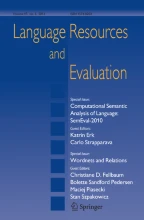Abstract
William Faulkner's non-chronological story tellingstyle has long been a challenge to critics and apuzzle to beginning literature students. ``A Rose forEmily,'' one of Faulkner's most frequently anthologizedstories, exemplifies the complexity of Faulkner'streatment of time. In this paper, we apply aconstraint-based problem solving method to an analysisof the chronology of ``A Rose for Emily.'' Constraintlogic programming is a declarative programminglanguage paradigm that solves problems by enforcingconstraints among variables. CLP's ability to sortnumeric variables that do not yet have definite valuesmakes it possible to sort the events of ``A Rose forEmily'' with only fragmented and relative timeinformation. In attempting to sort the events of thestory, we find an inconsistency in the temporalreferences scattered throughout the narrative. Afterremoving this inconsistency, we are able to compareour chronology with earlier ones and discuss thethematic relevance of Faulkner's nonlinear plots.
Similar content being viewed by others
References
Burg, J., S.-D. Lang and C.E. Hughes. “Intelligent Backtracking in CLP(R)”. Annals of Mathematics and Artificial Intelligence 17 (1996), 189–211.
Clocksin, W.F. and C.S. Mellish. Programming in Prolog, 3rd ed. New York: Springer-Verlag, 1987.
Cohen, J. “Constraint Logic Programming Languages”. Communications of the ACM 33(7) (1990), 52–68.
Colmerauer, A. “An Introduction to Prolog III”. Communications of the ACM 33(7) (1990), 69–90.
Cowley, M. “Introduction”. The Portable Faulkner. New York: Viking, 1946, pp. 1–24.
Faulkner, W. Collected Stories of William Faulkner. New York: Random, 1950.
Faulkner, W. The Sound and the Fury. (1929) The Corrected Text. New York: Vintage, 1990.
Going, William T. Chronology in Teaching “A Rose for Emily.” Reprinted in Inge, 76–83.
Hagopian, John V., W.G. Cunliffe and M. Dolch. “ 'A Rose for Emily' “ Reprinted in Inge, 76–83.
Inge, M. Thomas. William Faulkner: A Rose for Emily. The Charles Merrill Literary Casebook Series. Columbus, Ohio: Merrill, 1970.
Jaffar, et al. The CLP(R) Language and System. ACM Transactions on Programming Languages and Systems 14(3) (July 1992), 339–395.
Kowalski, R. “Algorithm = Logic + Control”. Communications of the ACM 22(7) (1979), 424–436.
Littler, Frank. “The Tangled Thread of Time: Faulkner's 'A Rose for Emily.' “ Notes on Mississippi Writers 14(2) (1982), 80–86.
McGlynn, P.D. The Chronology of “A Rose for Emily.” Reprinted in Inge, 90–92.
Moore, G.M. “Of Time and its Mathematical Progression: Problems of Chronology in Faulkner's 'A Rose for Emily.' “ Studies in Short Fiction 29 (1992), 195–204.
Nebeker, H.E. “Emily's Rose of Love: Thematic Implications of Point of View in Faulkner's 'A Rose for Emily.' “ Bulletin of the Rocky Mountain Modern Language Association 24 (1970), 3–13.
Nebeker, H.E. “Chronology Revised”. Studies in Short Fiction 8 (1971), 471–473.
Perry, M. “Literary Dynamics: How the Order of a Text Creates its Meanings” [With Analysis of Faulkner's “A Rose for Emily”]. Poetics Today 1(1–2) (Autumn 1979), 35–64, 311–361.
Sullivan, R. “The Narrator in 'A Rose for Emily.' “ Journal of Narrative Technique 1 (1971), 159–178.
Robinson, J.A. Logic and Logic Programming. Communications of the ACM 35(3) (1992), 40–64.
Schwab, Milinda. “A Watch for Emily”. Studies in Short Fiction 28(2) (1991), 215–217.
Sterling, L. and E. Shapiro. The Art of Prolog: Advanced Programming Techniques, 2nd ed. Cambridge: MIT Press, 1994.
Van Hentenryck, P. Constraint Satisfaction in Logic Programming. MIT Press, 1989.
Wilson, G.R., Jr. “The Chronology of Faulkner's 'A Rose for Emily' Again”. Notes on Mississippi Writers 5 (Fall 1972), 56, 58–62.
Woodward, R.H. The Chronology of “A Rose for Emily”. Reprinted in Inge, 84–86.
Author information
Authors and Affiliations
Rights and permissions
About this article
Cite this article
Burg, J., Boyle, A. & Lang, SD. Using Constraint Logic Programming to Analyze theChronology in ``A Rose for Emily''. Computers and the Humanities 34, 377–392 (2000). https://doi.org/10.1023/A:1026594916008
Issue Date:
DOI: https://doi.org/10.1023/A:1026594916008
